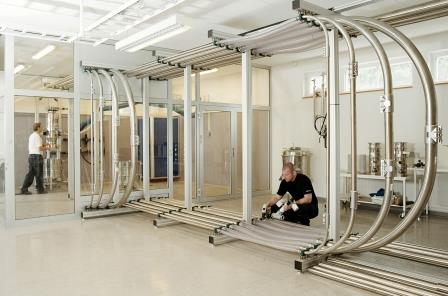Vacuum Conveyors Move Materials with Ease
January 28, 2014

Vacuum conveying technology has become an indispensable part of the manufacturing process. The growing reliance on vacuum conveying is not hard to understand once you consider its many advantages. It is enclosed, hygienic, and safe when transferring ingredients and finished products in many industries. Powders and granules are ideal for vacuum conveying as well as materials that are sensitive to humidity, contamination, and damage. An ideal system will optimize performance and increase overall productivity.
The most common types of pumps used in vacuum conveying systems are pneumatic and mechanical. Pneumatic vacuum pumps are smaller, more compact, and have virtually no moving parts. Mechanical blowers can be the correct choice if your facility does not have a reliable source of compressed air. A benefit of pneumatic pumps is their ability to operate intermittently by using a solenoid valve. A mechanical pump must run continuously unless cycle times are long enough to warrant shutting down the blower and restarting it for the next cycle. Pneumatic pumps offer minimal product degradation due to lower product flow velocities, excellent material containment, and ease of system configuration. Consequently, the heat, noise and contamination issues associated with mechanical pumps are eliminated.
It is a good idea to opt for a conveyor that can be modular or customized, allowing for flexibility. Because many powders and granules feature varying densities and flow characteristics, it is important that the conveyor be modular and capable of running a variety of different dry materials.
A conveyor should also be optimized for speed and performance based on application requirements. A vacuum conveying system is ideal for material being conveyed in a variety of industries because it is enclosed and safe—from source to destination – there is minimal risk of contamination or dust generation, thus improving the overall health and safety aspects of the process.
Filters are an integral component to the vacuum conveyor, because they prevent dust and fine particles from being drawn into the vacuum pump and escaping into the surroundings. There are several filtration options to consider. Pleated filters are ideal for powders with a particle size of .5 micron and greater. Some manufacturers offer conveyors that can be equipped with high-efficiency particle assay (HEPA) filters, which filter 99.9% of all dust particles.
Lab testing in the conveyor selection process is often overlooked. Make sure the lab is able to test-run a variety of powders and granules to assess conveying characteristics over various vertical and horizontal distances. You will also want the opportunity to view an analysis of volume conveyed over a given distance, as well as vacuum cycle time and energy consumption. Fluidization allows for compressed gas to pass through a porous cone, creating a cushion that reduces the coefficient of friction allowing non free-flowing material to discharge freely from the vacuum receiver.
Ideally, conveyors offer a relatively small footprint, allowing manufacturers to maximize floor space for product production. Conveyors for various industries should be constructed with a durable material in order to cope with the most demanding circumstances. Easy cleanability makes stainless steel the material of choice for strict hygiene conditions. Flow modulation changes the way material is conveyed and provides the operator with greater control over velocity for friable or blended materials.
Customers should look for a vendor that can provide a selection of accessories for the conveying system, such as feed wands, feed adapters, and portable stands. Like any industrial product, conveyors come with warranties that protect the user against costly repair during the warranty period. Having your employees manually “scoop” materials can put them at risk of breathing dust or chemicals into their lungs. Additionally, lifting and handling of heavy sacks can result in serious back or shoulder strain. With the proper conveying system, a greater number of materials can be safely conveyed, reducing the risks of employee inhalation or physical injury. Make sure your conveying equipment complies with the latest industry standards.
Clearly, a conveying system is not an “impulse” buy. It requires careful consideration of numerous criteria regarding performance, safety, ergonomics, and flexibility. But the time spent in this process will be an invaluable investment in the overall health of your manufacturing operation.
Brian Wilson is technical sales and support, Material Handling Group, Piab USA (Hingham, MA). For more information, call 781-337-7309 or visit www.piab.com.
For related equipment reviews, articles, and news, visit our Pneumatic Conveying Equipment Zone
Click here for information about International Powder & Bulk Solids Conference & Exhibition
You May Also Like


